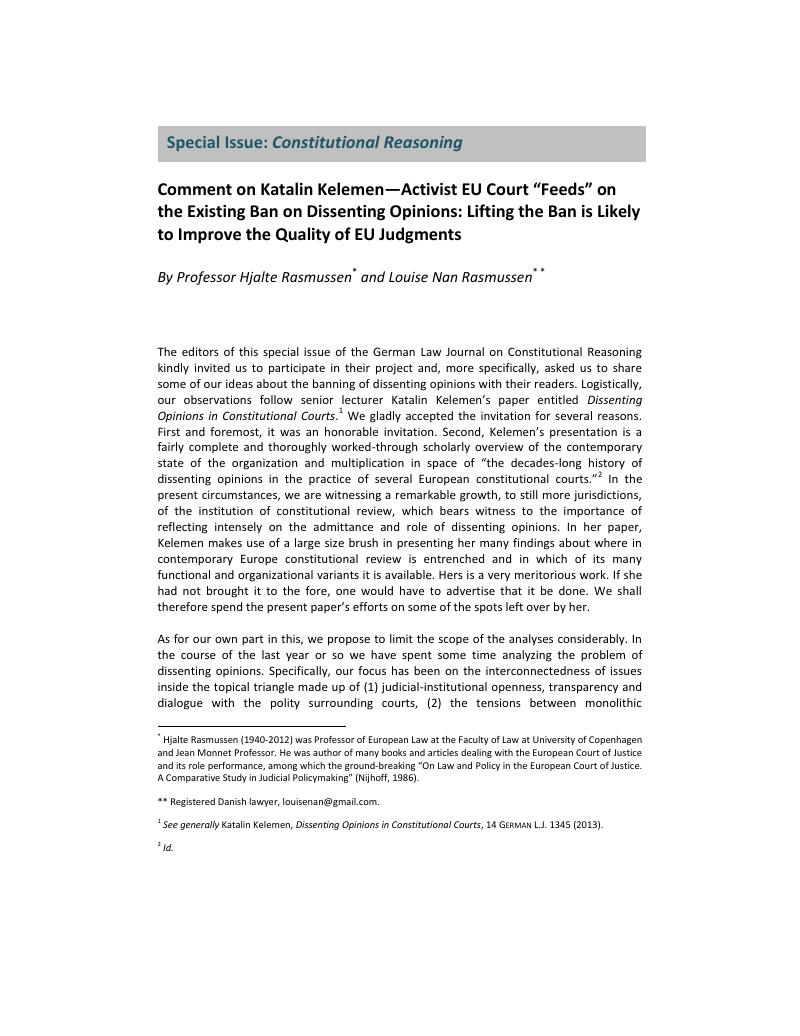Article contents
Comment on Katalin Kelemen—Activist EU Court “Feeds” on the Existing Ban on Dissenting Opinions: Lifting the Ban is Likely to Improve the Quality of EU Judgments
Published online by Cambridge University Press: 06 March 2019
Abstract

- Type
- Part B: Technique, Doctrine and Internal Logic of Constitutional Reasoning
- Information
- German Law Journal , Volume 14 , Issue 8: Special Issue - Constitutional Reasoning , 01 August 2013 , pp. 1373 - 1386
- Copyright
- Copyright © 2013 by German Law Journal GbR
References
1 See generally Kelemen, Katalin, Dissenting Opinions in Constitutional Courts, 14 German L.J. 1345 (2013).Google Scholar
2 Id. Google Scholar
3 Gilmour, David, The Pursuit of Italy 124 (2011).Google Scholar
4 Kelemen, , supra note 1.Google Scholar
5 Id. Because anyway most of what follows circulates around dissenting opinions, we refer for convenience below to dissenting and only occasionally to the more neutral term separate opinions.Google Scholar
6 We should note in passing that this paper uses democracy and terminological derivatives in a loose unspecified sense. It is about governmental action being “measured by the closeness, responsiveness, representativeness and the accountability of the governor to the governed.” J.J. Weiler, The Constitution of Europe 81 (1999).Google Scholar
7 The provision, first time occurring in the defunct Constitutional Treaty, is now in the Lisbon Treaty.Google Scholar
8 We might be under-informed on this point of importance.Google Scholar
9 Willensbildung is a German word, which it is difficult to translate into English. It encapsulates the ways and means by which–in our case–a group of judges and their institution strive to formulate a unanimous or divided will or intention on which it can build a necessary action, i.e. the handing down of a judgment (including the holdings to go with it).Google Scholar
10 Exceptions such as Joined Cases, Bernard Keck v. Daniel Mithouard, CJEU Case C-267–68/91, 1993 E.C.R. I-6097 [hereinafter Keck-case], and Metock and Others v. Minister For Justice, Equality and Law Reform, CJEU Case C-127/08, 2008 E.C.R. I-6241 [hereinafter Metock-ruling].Google Scholar
11 The Court's reasoning for overruling Sec'y of State for the Home Dep't v. Hacene Akrich, CJEU Case C-109/01, 2003 E.C.R. I-9607 in the Metock-ruling illustrates this point well.Google Scholar
12 The first time the Provision occurred was in the defunct Constitutional treaty; It is now in the Lisbon treaty.Google Scholar
13 For a fierce critique of the Court's poor reasoning–especially–ultra vires extensive interpretations of community powers, see generally Editorial Comments, The Court of Justice in the Limelight—Again, 45 Common Mkt. L. Rev 1571, 1571 (2008).Google Scholar
14 But for publishing judgments and some selected judicial statistics.Google Scholar
15 The terms “judicial activism” or “judicial imperialism” are short hand for the rather countless number of innovative and groundbreaking constitutional rulings which the Court has authored since the early years of the 1960s, all too often questionably within the clear warrants of the treaty's texts.Google Scholar
16 Mehren, Arthur von, The Judicial Process: A Comparative Analysis, 5 Am. J. of Comp. L. 197, 209, n.42 (1956). See also Kelemen, supra note 1.Google Scholar
17 Cf. Kelemen, , supra note 1.Google Scholar
18 Hjalte Rasmussen dealt in considerable detail with the decision to set up the Grand Chamber and the institutional and personal calamities in brought in its wake. See generally Hjalte Rasmussen, Present and Future EC-Judicial Problems After Enlargement and the Post-2005 Ideological Revolt, 44 Common Mkt. L. Rev. 1661, 1661 (2007).Google Scholar
19 One of them once told us that he appreciated a lot that Hjalte had published the first second-class analysis. Before, most of the non-privileged judges knew that they had been deliberately marginalized but also that the Court's leadership did not find it appropriate for anyone to air such grievances. He added that for his part Hjalte could as well have classified them as third class members of the Court.Google Scholar
20 Kelemen explained this to us.Google Scholar
21 Bingham, Tom, The Rule of Law 45–46 (2010).Google Scholar
22 Lexington, , Umpire of Liberty, The Economist, Mar. 31, 2012, at 49, available at http://www.economist.com/node/21551477.Google Scholar
- 4
- Cited by


